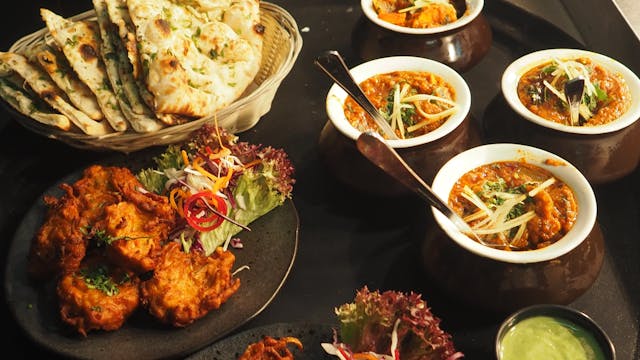Global Flavors: Exploring the World’s Most Unique Cuisines
Food is more than just sustenance; it’s a way to connect with cultures, histories, and people. Every country offers a unique culinary experience, shaped by geography, climate, and traditions. Whether it’s the vibrant spices of India or the delicate flavors of Japan, global cuisines offer an incredible diversity of tastes, textures, and techniques. In this article, we’ll take a flavorful journey around the world and explore some of the most unique and fascinating cuisines.

Indian Cuisine: A Symphony of Spices
A Rich Culinary Tradition
Indian cuisine is known for its bold, aromatic spices, which create layers of flavor that are both complex and comforting. From the heat of chili peppers to the warmth of turmeric, Indian food is an explosion of spices. Each region in India has its own specialties, influenced by climate, culture, and history.
What to Try
Popular dishes like biryani (a fragrant rice and meat dish), butter chicken (a creamy, spiced chicken curry), and dosa (crispy, fermented rice pancakes) showcase the range of flavors. Street food is also an essential part of Indian culture, with items like chaat (a tangy, crunchy snack) and samosas (fried pastries filled with potatoes and peas) offering a taste of the country’s bustling markets.
Japanese Cuisine: Precision and Simplicity
Balance and Elegance
Japanese cuisine emphasizes simplicity, seasonality, and aesthetics. Known for its precise preparation and presentation, Japanese food often features fresh, seasonal ingredients that highlight the natural flavors of the food. Rice, fish, and vegetables are staples, with fish being the centerpiece of many dishes.
What to Try
Sushi and sashimi are two iconic Japanese dishes that showcase the country’s expertise in working with raw fish. Tempura (battered and fried seafood or vegetables) and ramen (noodle soup) are also popular, as is wagyu beef, known for its tender texture and marbled fat. Don’t forget to sample traditional Japanese sweets like mochi (sweet rice cakes) for dessert.
Mexican Cuisine: A Flavorful Fiesta
Vibrant and Bold
Mexican cuisine is a colorful and diverse blend of indigenous ingredients like corn, beans, and chili peppers with influences from Spanish, African, and Asian cuisines. The food is full of bold flavors, from smoky salsas to tangy citrus, and is often served with a side of fresh tortillas or tacos.
What to Try
Tacos, enchiladas, and quesadillas are popular staples, but there are many regional specialties to discover. Try pozole, a hearty soup made with hominy, meat, and chili, or mole, a rich, chocolate-infused sauce served with meats. Don’t miss out on tamales, corn dough wrapped in leaves and filled with meats or vegetables, and churros for a sweet treat.
Ethiopian Cuisine: A Shared Dining Experience
Communal and Flavorful
Ethiopian cuisine is known for its communal style of eating, where food is shared from a single platter and eaten with injera, a large, spongy flatbread made from teff flour. The use of berbere (a spicy, aromatic seasoning mix) and niter kibbeh (clarified butter infused with spices) gives Ethiopian food its distinct flavors.
What to Try
Doro wat, a spicy chicken stew, and kitfo, minced raw beef mixed with spices, are two popular dishes that showcase the richness of Ethiopian flavors. A traditional meal is often served with various stews and vegetables, and everything is eaten using injera as both a utensil and a base. The communal aspect of Ethiopian dining makes it a unique and social experience.
Thai Cuisine: Balancing Sweet, Sour, Salty, and Spicy
Complex and Harmonious
Thai cuisine is renowned for its balanced and harmonious flavors, where sweet, sour, salty, and spicy elements all come together in perfect harmony. Thai food makes use of fresh herbs like basil, lemongrass, and cilantro, as well as bold ingredients like fish sauce and lime.
What to Try
Pad Thai, a stir-fried noodle dish, and green curry, a fragrant, spicy coconut milk-based soup, are two well-known Thai dishes. Tom yum soup, with its spicy and sour broth, and som tam, a tangy papaya salad, are also staples. Don’t forget to try Thai iced tea, a sweet, creamy beverage made with black tea and condensed milk.
Lebanese Cuisine: Fresh and Flavorful
Mediterranean Delights
Lebanese cuisine is part of the larger Mediterranean culinary tradition, known for its emphasis on fresh vegetables, grains, olive oil, and herbs. It features a variety of dips, salads, and grilled meats that highlight the flavors of the region.
What to Try
Mezze, a selection of small dishes meant for sharing, is a great way to experience Lebanese food. Hummus (a creamy dip made from chickpeas), baba ganoush (smoky eggplant dip), and tabbouleh (a fresh parsley and bulgur salad) are all staples. Shawarma, spiced and grilled meat served in pita bread, is also a popular choice.
Peruvian Cuisine: A Fusion of Indigenous and Global Flavors
A Culinary Melting Pot
Peruvian cuisine is a fusion of indigenous ingredients and techniques with influences from Spain, Africa, China, and Japan. The diversity of the country’s geography, from coastal areas to the Andes Mountains, has resulted in a wide variety of regional specialties.
What to Try
Ceviche, a dish of raw fish marinated in citrus juice and served with onions and cilantro, is a signature Peruvian dish. Lomo saltado, a stir-fried beef dish with vegetables and rice, reflects the country’s Chinese influence. For dessert, try the sweet, spongy cake called tres leches, soaked in three kinds of milk.
Korean Cuisine: A Flavorful and Nutrient-Packed Tradition
Fermentation and Bold Flavors
Korean cuisine places a strong emphasis on fermentation and the use of bold, salty, spicy, and sour flavors. Kimchi, a staple in Korean households, is a fermented vegetable dish made with napa cabbage, radishes, and chili peppers, and serves as a side dish with nearly every meal.
What to Try
Bibimbap, a rice dish topped with vegetables, eggs, and spicy gochujang sauce, is a well-known Korean meal. Korean barbecue, where diners grill their own meats at the table, is a fun and flavorful experience. Don’t miss out on traditional desserts like bingsu, a shaved ice treat topped with red beans, fruit, and condensed milk.
French Cuisine: Refined and Elegant
Artistry in Cooking
French cuisine is known for its refinement, attention to detail, and artistic presentation. From croissants and baguettes to gourmet dishes like coq au vin and escargot, French food emphasizes high-quality ingredients and classic techniques.
What to Try
A visit to France wouldn’t be complete without trying croissants, delicate pastries filled with butter and flaky layers. Coq au vin, chicken cooked in red wine, and ratatouille, a vegetable medley, showcase the depth of French flavors. Don’t forget to sample a selection of French cheeses and indulge in a decadent crème brûlée for dessert.

Spanish Cuisine: Bold, Hearty, and Flavorful
Celebrating Local Ingredients
Spanish cuisine is all about celebrating the vibrant, fresh ingredients found across the country’s diverse regions. Olive oil, seafood, cured meats, and vegetables feature prominently in many dishes, and meals are often enjoyed in a communal, family-oriented setting.
What to Try
Paella, a rice dish typically made with seafood, chicken, and saffron, is one of Spain’s most famous dishes. Tapas, small plates meant for sharing, are a fun way to sample various Spanish flavors. Jamón ibérico, a type of cured ham, and churros with hot chocolate are must-tries for anyone visiting Spain.
Conclusion: A World of Flavors
Exploring the world’s unique cuisines is a journey that introduces you to new ingredients, cooking techniques, and cultural traditions. From the spicy stews of Ethiopia to the delicate sushi of Japan, food is a gateway to understanding different ways of life. So the next time you’re craving something new, consider exploring the global flavors that await, and take your taste buds on an unforgettable adventure.












